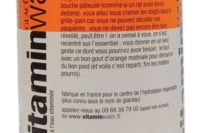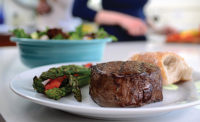TECHNOLOGY UPDATE: Light Shines on Food Safety
Show Me the Light
UV light at a wavelength of 253.7 nanometers is an effective germicide against yeast, molds, bacteria, viruses and algae. Altering microbial DNA, its effects can be determined by controlling the intensity and time of exposure.The principle application is in a water treatment, where foods floating in water flow past UV lamps that deliver a lethal dose of monochromatic light energy. Depending upon the system, disinfection is accomplished in 6-10 seconds in the flow-through channel. For a comparable log reduction ("kill") of microorganisms using chlorine at 3-5ppm, a 15-20 minute treatment would be required.
UV disinfecting has a number of advantages. These include:
- Environmentally friendly; no chemicals used.
- Greater operator safety; chemicals not handled.
- Effective on a range of pathogens, although spores are not destroyed.
- Rapid treatments.
- Low operating costs.
- Fairly low capital expenditures.
- Simple operation.
- Minimal maintenance .
The main disadvantage of UV treatment is that light cannot penetrate opaque substances and that it can be used only for surface or film treatments. Concerns over unpasteurized juice have encouraged investigators to look at UV as a processing tool. According to Randy Worobo, Ph.D., Cornell Univeristy, 200-plus small apple processors now use UV treatment on apple juice and cider products.
Some UV units are also being marketed to the meat industry for surface disinfecting of packaged meats and also for food packaging materials, especially with dairy products.
One disadvantage in working with light systems is a phenomenon called "shadowing." Rough surfaces may offer shade and, thus, protection for microorganisms. The most successful strategies to combat shadowing have been demonstrated with chicken skin, tomatoes and certain types of bread. Manufacturers acknowledge that, in products with rough surfaces, effectiveness of the treatment will always be lower.
Processes using light of wavelengths ranging from the short ultraviolet to the long infrared also have been commercialized. For example, PurePulse Inc., San Diego, Calif., has a system called PureBright, which emits a broadband white light from a xenon gas lamp. Pulses typically last 100-300 microseconds, and the lamps are flashed one to 20 times per second. Generated light is non-ionizing and will not penetrate opaque materials.
White light can be used to control microorganisms on food and packaging materials, in water and in air. Data from the company shows that a fraction of a second exposure reduces the number of Aspergillus niger spores by 7 logs, whereas UV required 6-10 seconds for a 3.5 to 4.5 log reduction. PurePulse has, however, decided to re-focus efforts on medical applications.
A Pressure-filled Process
High pressure processing exposes foods to pressures of 100 to 800 MPa (mega pascal). Unlike light systems, pressure processing affects the whole mass of the food, regardless of size, shape or food composition. Pressure is applied uniformly to the food mass, and as a result, processed products retain their shape and size. Microorganisms are killed through the interruption of cellular function. The rate of microbial destruction is a function of a number of factors such as the process (pressure, time and temperature); the product (e.g., pH and preservatives); and the application of other "hurdles." For example, product temperature increases the treatment's lethality.Due to the nature of the process, companies interested in producing high value, sensitive products were among the first to adopt pressure processing. Examples include fruit jams where processors wished to preserve the integrity of the fruit for the Japanese market and guacamole for the U.S. retail and institutional markets. In shellfish, pressure processing not only eliminates pathogenic organisms--such as viruses and Vibrio--it also affects the muscles in the mollusk, allowing it to be shucked more easily.
Flow International of Kent, Wash., manufactures batch and continuous processing systems. In the former, the package is placed in a handling basket and loaded into a pressure vessel. Batch systems allow the use of conventional filling systems and accommodate liquid and solid products. The continuous system is applicable for products that can be pumped and uses a device called an "isolator." Food is pumped into the isolator, which segregates it from the UHP (ultra high pressure) water source. The food is pressurized and then pumped to an aseptic filling station. In effect, the system is a continuous batch system.
|
||||||||||||||||||||||||||||||||||||||||||||||||||||||||||||||||||||||||||||||||||||||||||||||||
No Waste Radiation
Electron beam sterilization, common in the medical industry, has moved to food processing. Electron beam irradiation has a distinct advantage in that no radioactive waste is produced. Foods treated with ionizing radiation must be labeled as such. Relatively consumer-friendly terms such as "cold pasteurized" and "electronic pasteurization" can be used.In these systems, devices such as a linear accelerator produce electron beams (or x-rays) with energy that ranges from about 5 to 10 electron volts. The beam (electrons at the speed of light) is scanned across the food product. The energy is sufficient to allow the beam to penetrate both individual packages and cased product. Bacteria are eliminated through disruption of DNA; that is, they are unable to reproduce after treatment.
A number of companies have adopted this technology, including Minnesota-based Huisken Meats. It was the first to roll out products treated with ionizing radiation and recently introduced several new products, including five ground beef patty products and a two-lb. beef chub. The technology is being examined as a means to eliminate Listeria and to assure the safety of ready-to-eat meats, such as luncheon meats or hot dogs.
Future Episodes
The use of pressure processing and "cold pasteurization" appears to be gaining ground in the U.S. food processing industry, while adaptation of UV or white light has been is slower.
Consumers often overlook the times they throw out all or part of a moldy loaf of bread or a pound of hamburger found in the back of the refrigerator that has developed a personality of its own. Worldwide, food spoilage results in significant loss. Its prevention or inhibition is an integral part of product and process development.
Rick Stier consults for the food industry on processing and safety issues. He is currently on assignment in Egypt and can be reached at rickstier4@aol.com.
Looking for a reprint of this article?
From high-res PDFs to custom plaques, order your copy today!





